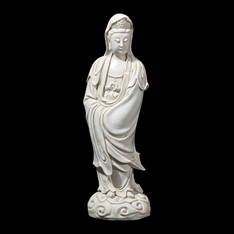
Spanish School; End of XVII century. "Christ supported
Similar Sale History
View More Items in PaintingsRelated Paintings
More Items in Spanish Paintings
View MoreRecommended Art
View More











Item Details
Description
Spanish School; End of XVII century."Christ supported by angels".Oil on canvas. Relined.Presents repainting pomp of air and hole in the canvas.Measures: 207 x 177 cm.Two angels hold the recumbent body of Jesus, with the head bent backwards, the body swollen and with a grayish tonality, the author shows us the death of Christ. Through a human body, rotund, which fades between the arms of the angels. A game of contrasts between the living and the dead, between a body abandoned by life, and the expressiveness of the colors of the angels' tunics. In this sense it is also worth mentioning the presence of two small little angels that carry the attributes of the passion of Christ, the nails and the crown of thorns. In addition, in the lower foreground, there is a bronze basin with remains of the blood of Jesus, accompanied by the band that reads INRI. Aesthetically the piece follows the guidelines imposed by Van Dyck.Van Dyck opened a personal workshop as a teenager, at the age of sixteen, together with his young friend Jan Brueghel the Younger. It should be noted that Van Dyck worked closely with Rubens, of whom he became an assistant, leaving his independent workshop. In the workshop of Rubens, by then a painter known throughout Europe, Van Dyck made his name known in the environments of the aristocracy and the rich bourgeoisie and came into contact with classical culture and court etiquette.Anton Van Dyck was a key painter of the Flemish Baroque and one of the most important portraitists of the 17th century. He began his training with Van Balen, a Romanist painter, in 1609. In 1615-16 he worked with Jordaens, and between 1617 and 1620 with Rubens, who said that he was his best pupil. In 1620 he visited England for the first time, in the service of James I. In London he enjoyed greater freedom and left aside religious painting to devote himself fully to portraiture. Between 1621 and 1627 he completed his training with a trip to Italy, where he was impressed by Bolognese painting and the works of Titian, and here he achieved his mature, refined and elegant style, as well as establishing his own type of portrait, which became a model for Western painting. In 1629 he was again in London, this time working for King Charles I, who admired Titian's work and saw in Van Dyck his heir. Thus, he dismissed all his painters, having found in Van Dyck the court painter he had wanted for years. In 1640, on the death of Rubens, the painter returned to Antwerp to finish the works he had left unfinished. The following year he moved to Paris, and returned to London for health reasons, dying shortly thereafter at his home in the English capital. Anton Van Dyck is represented in major museums around the world: the Louvre, the Prado, the Kunsthistorisches in Vienna, the National Gallery and the British Museum in London, the Hermitage in St. Petersburg and the Metropolitan in New York.
Buyer's Premium
- 23%
Spanish School; End of XVII century. "Christ supported
Estimate €6,000 - €7,000
2 bidders are watching this item.
Get approved to bid.
Shipping & Pickup Options
Item located in Barcelona, -, ESOffers In-House Shipping
Payment

TOP























































































